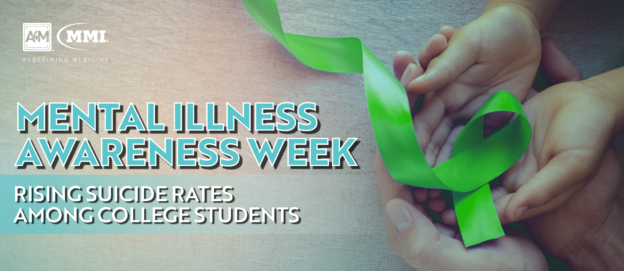Sunday, October 6th marks the beginning of Mental Illness Awareness Week 2019 across the United States, during which the National Alliance on Mental Health (NAMI) and other psychological support organizations come together to spread awareness and fight the stigma that remains enveloped in the conversation surrounding mental illness. Despite their prevalence – 1 in 5 adults will experience mental illness in this year alone – mental health conditions are often minimized and treated with less urgency than physical illness. This has allowed intentional self-harm to become the 10th leading cause of death in the United States, and the 2nd most common cause among college students.
Suicide Rates at an All-Time High
Suicide rates have increased by over 25% in the past two decades and continue to rise, although, stigma and shame lead to insufficient media coverage and a lack of awareness. The recent suicide of a teenage Harvard student, Luke Tang, has reignited a critical conversation about mental illness, its life-threatening effects, and the climbing suicide-related mortality rates among young adults – teenagers, college students, and young working professionals.
College Student Population
The National Institute of Mental Health reports the highest prevalence of serious suicidal thoughts in adults aged between 18 and 25, at a rate of 10.5%. Twice as many men aged between 20 and 24 commit suicide than women, although, young women attempt suicide three times more often than men. These statistics underscore the momentous impact of mental health on the mortality rates of young adults, in particular, college students facing inordinate stress and with limited therapeutic resources.
In the state of Massachusetts alone, 214 students aged 18 to 24 committed suicide between 2007 and 2016, per public health records examined by the Boston Globe – that is a 43% increase in deaths from the previous decade. Recent research has revealed that 1,100 suicides occur at colleges per year and some are at an increased risk due to financial aid, crime rates, and other stressful compounding factors. These include some of the top-ranked colleges in the country: Washington University, University of Pennsylvania, Columbia University, Harvard University, and Northwestern University.
Racial Considerations
Luke Tang’s suicide has prompted investigations into the role of racial and cultural discrimination that may influence the rising suicide rates among minority students of elite universities. Between the years 2007 and 2017 at least nine Harvard undergraduates committed suicide – six of the were of Asian descent. Asian students in particular face an unmet need for mental health services, with data revealing that only 23% of those needing counseling actually seek professional help. Asian-Americans make up nearly 20% of the Harvard undergraduate student body, however, there is little done about the particular vulnerabilities minorities face both at Harvard and at other schools nationwide.
Mental Health Awareness Week
Although Harvard officials declined to comment on campus suicide rates and Tang’s death, his story is raising questions about the responsibilities of universities and their approach to mental health, underscoring the lack of diverse support services for minorities. There is an urgent need to better understand the implications of race on college student mental health, as well as the reasons behind the rising suicide rates among young adults.
In part due to grief, privacy, and reluctance, these stories of student suicides are rarely publicized. The lack of media coverage furthers the associated stigma rather than making room for an open dialogue about mental health, in which individuals can seek support and suicide prevention efforts can be enhanced. Efforts such as the NAMI’s Mental Illness Awareness Week aim to promote such openness, advocate for the mentally ill, and raise awareness of the alarming prevalence of these conditions affecting the lives of one-fifth of the national population.
While close personal relationships and easily accessible support can greatly benefit those with mental illness, professional treatment and counseling services are critical to helping manage symptoms and preventing the progression to suicidal ideation or suicide attempts. Recent tragedies and the spike in suicide prevalence highlight the need for universities and schools nationwide to improve their wellness and mental health resources. Furthermore, equipping the public with knowledge of support strategies for family, friends, or anyone suffering from a mental health condition can help save lives and reverse the alarming trend in suicide rates troubling the nation.

